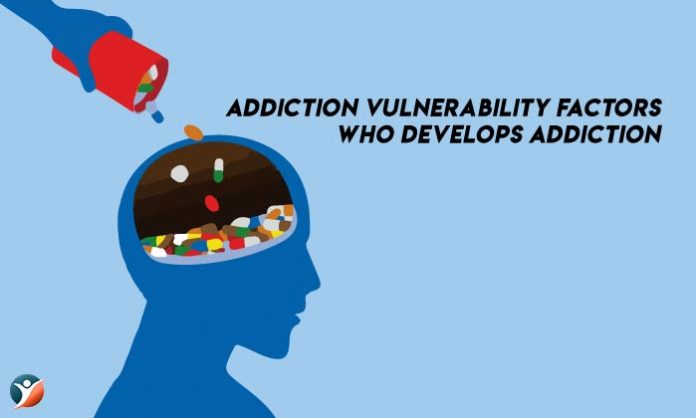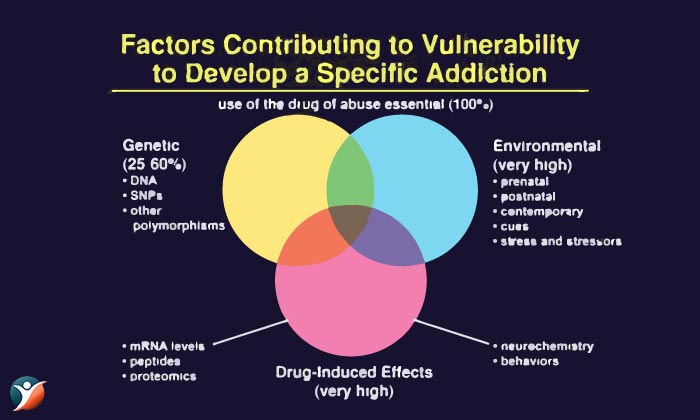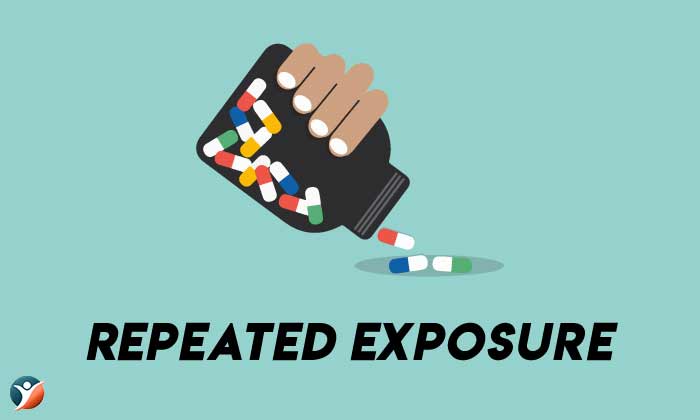
Addiction is a complex brain and body disease that involves compulsively using a substance irrespective of the social and health consequences. Addiction disrupts the brain regions that manage motivation, reward, judgment, learning, memory. It damages the system of the body and disturbs relationships, careers, schools, workplaces, neighborhoods.
Table of Contents
- Introduction
- Addiction Risk Factors
- Role of Genes
- Can Anyone Get Addicted?
- Three Factor Model
- Conclusion
Many people engage in risky use of drugs and alcohol and make themselves vulnerable to addiction or substance abuse. In some people, this abuse of substances may progress to severe mental condition called addiction. Alcohol and drug use have a negative effect on everyone who uses it, as well as people around him or her irrespective of their age, ethnicity, gender, economic status. Many people who use drugs and alcohol regularly may not get addicted to it while as some people can develop addiction even if they use these substances even in moderation. So, what are the risk factors which can predispose people towards substance towards addiction.
Addiction Risk Factors
Just like any other condition, there are certain risk factors which when present in a person can push him into clutches of addiction. These are:
- Genetic Predisposition
- Psychological factors like stress, personality traits like more prone to depression, high impulsivity, eating disorders, sensation seeking, psychiatric and personality disorders.
- Certain characteristics of brain that can increase the likelihood to addiction than the normal person.
- Environmental influences like getting exposed to physical, emotional, sexual abuse or trauma [1], substance abuse or addiction in the family or among peers, easy accessibility to an addictive substance, exposure to cultural references that promote the use of substance
- Using drugs, nicotine, alcohol at an early stage.
Well these addiction risk factors do not mean that someone will necessarily become addicted but it does mean that the likelihood is greater. The more the risk factors, the greater the chance that the disease will develop.
Role of Genes
There are psychological and environmental factors that determine whether an individual will use substances or drugs, but there are genetic factors [2] as well which determine who goes on from substance abuse to addiction.
Can Anyone Get Addicted?
Well, the answer to this is yes! Some of the drugs are so addictive like heroin, nicotine that excessive use of these or having them on a daily basis can cause addiction to anyone who uses them.
People from all backgrounds can experience addiction. It is difficult to know why some people have greater likelihood than others. Apart from your upbringing or moral values there are many factors that can elevate the risk of becoming addicted to alcohol and other drugs.
Addiction is not a matter of loose morals or weak will power. The chemical reactions that occur in the brain of someone with addiction are quite different from the ones without. This explains why one person may smoke every now and then for pleasure while the other requires them on an everyday basis to function.
Heredity is a risk factor for addiction. According to National Institute on Drug Abuse, up to 50% of your chances of addiction to nicotine, drugs, alcohol is genetic.[3] . If you are having family members who have struggled with addiction, you will also experience it. If your personality is “addictive type” you may have likelihood of getting addicted.
Addiction vulnerability is the risk of an individual of developing addiction during their lifetime. There are many environmental and genetic risk factors which result in the development of addiction. Each contributes to around half of the risk of developing addiction. Even in individuals who do not have a high genetic risk, getting exposed to high quantities of addictive drugs for a long period of time can cause addiction. So basically, anyone can become an addict.
Three Factor Model
Research has established that some people are more vulnerable to addiction and there is a three-factor standard for vulnerability to addiction:
Environmental factors
Genetic factors
Long term and repeated exposure to substances of abuse.
Being vulnerable to addiction means that someone is more likely to develop an addiction as compared to other individuals. Further many in the scientific community say that addiction is not the result of desensitized neural receptors but long term associated memories of substance abuse. Addiction vulnerability has psychological and physiological components.

Genetic Factors
Genetics is a major factor in addiction vulnerability. 40-60% of the vulnerability to addiction is genetics. A particular gene D2 subtype of dopamine receptor has been examined in detail for its association with substance addiction. The D2receptor responds to dopamine which is responsible for creating pleasurable and rewarding feelings in brain. Mice studies have been done which suggest that individuals having deficiency of dopamine receptor exhibit a preference for increasing the consumption of alcohol over their counterparts and also compensated levels of cannabinoid receptor type CB1
Individuals having deficiency in D2dopamine receptor have more likelihood of seeking out pleasure producing substances as they are less responsive to the natural feel good effects of dopamine. Research shows that GABA also has a role to play in vulnerability to addiction. Genetics also plays a role in putting a person at an increased risk of using and experimenting with drugs, chances of relapse and continual use of drugs. Sometimes individual traits like reward seeking, impulsivity, response to stress can increase the chances of vulnerability to addiction.

Environmental Factors
An environmental factor that ups the chances of vulnerability of addiction is easy accessibility to drugs. Other factors like poor relationships among family members, socio economic status etc. are factors responsible for initiating and continued drug abuse. Neurobiology also plays a role. Stressors can put the brain in a compromised state. Factors like family problems and financial concerns can affect the brain physiology.
Stress and trauma have neuroadaptive effect so that the brain can rewire itself for accommodating increased cortisol production due to stress. There is also evidence that stress affects the prefrontal functioning and increases limbic strata level response. This can result in low cognitive and behavioral control. Additionally, when the brain is under too much of stress due to repeated drug use, it gets changed physiologically.

Repeated Exposure
Researchers say that addiction is the result of transition from goal directed actions to habits and eventual drug seeking and taking behavior. So deliberate and repeated use of the drug plays a role in compulsive drug taking. A different theory suggests that when the drug is used repeatedly, individuals develop sensation to the stimuli associated with drug which results in excessive desire for the drug. Another neurobiological theory talks about the alterations in the brain reward circuitry after repeated drug use that leads to the development of addiction. Experience dependent neural plasticity represents repeated drug exposure and refers to brain adaptation due to increased levels of drug in the body. This way repeated exposure falls under both physiological and psychological vulnerability to addiction. Many variables contribute to increasing the risk of developing substance use disorder, no single vulnerability guarantees addiction. The combination of various factors results in the development of the disorder.

Conclusion
Many factors are associated with increase in the risk of substance abuse like individual differences (decreased harm avoidance, low motivation towards achievement, negative effect), biological (neurological development, genetic predisposition), environmental factors (easy availability of substances, high stress levels, influence of peers) Studies on rats have confirmed that adolescence is a period of increased risk and vulnerability to drug taking and addiction. During adolescence, the mesolimbic dopamine system of the brain undergoes functional changes and reorganization. Adolescents have greater tendencies to drink than adults because of minimal interference to their motor function and minimal sensitivity to sedation. Thus, the likelihood of getting addicted to substance becomes more in this period. Thus, social, developmental and behavioral factors during adolescence subject individuals to drug seeking behavior, and consequently addiction.






